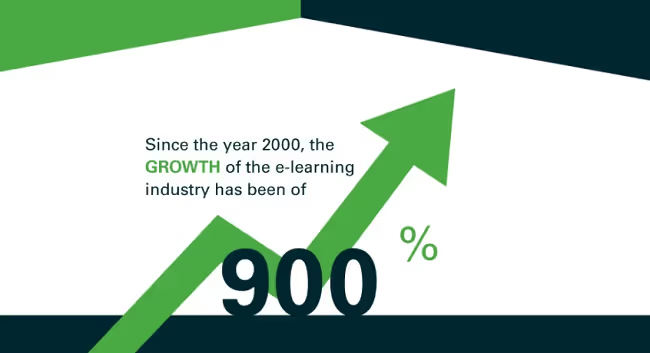




Key Takeaways
- Unlock the Flexibility of Distance Learning with Cutting-Edge Technology: Discover how distance learning leverages the latest technology to bring flexibility and accessibility to education. Learn how you can study from anywhere, at any time, without sacrificing quality
- Overcome the Top Challenges of Distance Learning with Proven Solutions: Uncover the biggest hurdles students face in distance learning, like lack of interaction and time management, and find out how to tackle these issues with practical, easy-to-implement strategies
- Explore the Global Growth of Distance Learning and Its Future Trends: Dive into the remarkable rise of distance learning across the globe, with over 220 million students enrolled in 2023. Find out how technological innovations like VR and AI will shape the future of education
With the advancement of technology in every field, including education, distance learning can be said to be a revolutionary approach to acquiring knowledge.
You might be shocked to know that more than 6.3 million students in the USA are engaged in distance learning. This is not just a trend but a new paradigm of education that has brought classes through the Internet. For example, for the working professional who perhaps desires to study at a university that is miles away from their workplace or the stay-at-home mum who wishes to advance her education, distance learning offers remarkable convenience and flexibility.
However, similar to any educational technology or other revolutionary concept in the field of education, distance learning is not without certain issues. With the increasing adoption of this type of learning, it is only befitting that one gets to appreciate the opportunities and challenges associated with it. The following article is designed to serve as an introduction to distance learning, where it discusses what this type of educational paradigm can do for you, as well as what potential problems it can pose.
What is Distance Learning?
Distance learning or distance education is a learning system where the teachers and learners cannot interact physically due to factors such as space and time. These students cannot attend classes physically; instead, they participate in distance learning activities through online correspondences or mixed methods.

This mode of education allows learners to undertake any course or access any other educational programs or resources without physically going to class or school.
Critical Aspects of Distance Learning
- Technology Integration is a cornerstone of distance learning. It encompasses modern tools such as Learning Management Systems (LMS), video conferencing, and multimedia-rich learning materials.
- Types of Distance Learning: Distance learning can be further classified into synchronous, asynchronous, and hybrid modes of delivery based on the extent of interaction required during learning.
- Accreditation: Most distance learning programs are affiliated with accredited institutions, meaning the education offered falls within specific quality parameters.
- Popularity: Distance learning as a form of education has increasingly gained popularity due to technological advancements. According to data, in 2023, more than 220 million students worldwide were enrolled in distance education.
- Accessibility: As stated, distance learning opens up educational chances to some people who cannot attend classic classes because of geographical, financial, or personal barriers.
History of Distance Learning

Distance learning is a fairly old concept in the history of education, which has undergone significant changes over the centuries, from paper-based correspondence courses to modern online platforms that unite students from different countries. From a means of offering learning to learners who could not attend institutional education, it has developed into virtually a worldwide system that disseminates knowledge through advanced technologies.
Below is a year-wise breakdown of critical milestones in the history of distance learning:
- 1728- Caleb Phillips is said to have offered lessons in shorthand and offered to teach elaborate lessons through weekly mail in the Boston Gazette.
- 1840: The first modern distance education was established by Sir Isaac Pitman in England, where he offered shorthand courses, posted the material to the students, and returned the completed work by post.
- 1873: Another notion that stemmed from the ideas of a woman was the Society to Encourage Studies at Home in the U. S., which was the first correspondence school for women.
- 1922: This year, the University of Pennsylvania began using radio in teaching, making education accessible to distant students.
- 1950s: Television courses became popular, with institutions like the University of Iowa broadcasting courses to students across the state.
- 1969: The establishment of the Open University in the United Kingdom contributed to the development of modern distance education as it provided televised and broadcasted courses alongside traditional correspondence.
- 1980: The first distance education program that was entirely online was in 1984, the University of Toronto used computer networking to offer courses.
- 1993: Jones International University became the first accredited online university, paving the way for the growth of the online education system in the future years.
- 2004: The evolution to Web 2. 0 technologies encouraged more interactive and user-contributed information and education, thus creating online environments like Moodle and Blackboard that joined the distance education culture.
- 2012: The emergence of MOOCs from platforms such as Coursera and edX made education accessible to millions of learners globally as they could register for classes offered by reputable institutions.
- 2020: With the advent of the COVID-19 pandemic, schools, colleges, and universities across the globe have shifted to an online mode of education overnight, which has provided the much-needed impetus to this mode of learning in the education industry.
This timeline shows how distance learning has continuously evolved in its capacity and reach in response to changing technological trends.
Types of Distance Learning
Distance learning is not just a standardized system but a diverse system of distance education courses that can be effective for every learner. There are various and asynchronous distance education and learning modes based on the learner engagement mode and communication with the instructors and fellow learners.
Each type provides a combination of flexibility and structure that helps you determine which type is best suited for your lifestyle and learning.
Here are some of the most common types of distance learning:
1. Synchronous Distance Learning
This type of learning can take place in real-time. One option is to continue attending your classes online and at the same time, be able to physically meet your instructor and other students. Synchronous learning is usually characterized by traditional classroom settings or the use of live video lectures, webinars, fixed-time online courses, and other forms of structured, time-bound sessions; it is ideal for learners who enjoy structure and direct communication.
2. Asynchronous Distance Learning
Conversely, asynchronous learning is flexible to enable the student to open and schedule the online courses and learn freely. They have no live sessions where students can engage with the teacher; instead, students can open scheduled online courses and access materials like videos, articles, and quizzes whenever they wish. This type is great if you have a job, other engagements or simply wish to study with some schedule flexibility not bound by certain hours.
3. Hybrid Distance Learning
Synchronous and asynchronous proposed styles of learning are applied in combination with each other in hybrid learning. This implies that while you could attend face-to-face lectures once or twice a week, the rest of the course material content is delivered in a non-synchronized fashion. Although it does not provide strict structures for the discussions, this approach permits real-time conversations and feedback.
4. Video Conferencing
This type of distance learning includes video conferencing interfaces that help students and instructors get together in a virtual environment. It engages in most operations and is usually applied in group work or discussion forums. It’s like being in an actual classroom learning process physically present but being a virtual learning process that is being undertaken.
5. Correspondence Courses
One of the first methods of using teaching methods for distance education is correspondence courses where students and teachers exchange instructional materials through mail or e-mail. Despite it is not used frequently as it was some time ago, there are places in the world where individuals require assistance in navigating the World Wide Web; for instance, in African countries, You receive your assignments, complete them independently, and submit them to your teacher to check out.
Who Uses Distance Learning?
What used to be an innovative form of receiving education is now a customary method of learning, preferred by students from all walks of life and employers. To the students in need of a flexible study schedule, the working professionals who want to advance in their careers, or businesses that need their employees trained, distance learning is a one-stop-shop that provides a solution for all these cases.
Here's a look at who benefits most from this flexible mode of education:
1. Students
From high school to college students, distance learning affords education without needing to commute to a specific place. As such, it benefits learners who may have to juggle school and other responsibilities such as part-time jobs, internships, or family-related engagements.
2. Working Professionals
Distance learning allows people striving for career progression to increase their knowledge or earn a new credential while working. They can study without time constraints, whether it's shorter courses, full-length degree programs, or professional certifications.
3. Companies
Many companies effectively use distance learning to educate their employees, provide them with important information concerning the latest technological developments, and provide them with the necessary tools to operate competitively within today's economy. It is relatively inexpensive and flexible in delivering, it offers the ability to meet specific organizational requirements, and due to its efficiency, it is engaging for corporal training needs.
4. International Students
Distance learning creates a chance for students who live in countries where some traditional education programs are not offered to receive education from the best world universities and courses. They can acquire degrees from reputable universities for in-person education without shifting to another university.
Distance learning has emerged as one of the most adaptable and accessible learning models that fits all categories of learners and organizations. It's revolutionizing the perception of education by making it easier and more flexible than ever.
What Are the Benefits of Distance Learning?
Distance learning has become a popular method of education since it provides numerous benefits for different requirements and schedules. Whether you are a student with a family and a job, a working professional, or an organization that seeks to train its staff, distance learning offers advantages that face-to-face learning doesn’t always provide.
Here are some of the critical advantages of this flexible and accessible learning model:
1. Flexibility
Flexibility is one of the significant advantages of distance learning, as a person can study whenever they want. This option suits people with a job, children, or other obligations. For example, a working parent can do coursework after the kids are asleep in the evening, or a full-time employee can study on weekends but lose his position.
2. Accessibility
Distance learning erases geographical barriers, and education becomes possible for everyone, including those who reside in remote areas.
For instance, a student from a rural background who lacks proximity to universities can take an online degree program from an Ivy League University located on the other side of the world. This creates chances that would otherwise not be possible due to geographic limitations.
3. Cost-Effectiveness
Distance learning is sometimes cheaper than conventional learning on college and university campuses. It also saves a lot of money because students don’t have to spend money on commuting, housing, or other expenses on campus. Furthermore, most online distance education programs are more affordable than most traditional classroom courses or face-to-face courses in terms of tuition fees.
For instance, a student may opt for an online program for a Master’s degree, which costs far less than an on-campus program, but the quality of education is comparable.
4. Self-Paced Learning
Since a distance learning course is an independent course, the learner can manage the course's study at their own pace, taking as much time as the individual requires. This is especially helpful to learners who need more time to grasp the concepts or may wish to take a shorter time to complete the course.
For instance, a student with prior information knowledge may finish a course in a shorter time than that set timeframe. In comparison, a learner with no previous knowledge about the course content may require more time to finish the same course.
5. Wide Range of Programs
Thousands of courses and programs are available online, ranging from certifications to full degrees in nearly every field of study. Online courses are now massive open online courses available for virtually every topic you could think of, whether a more specific area or a more general one.
For instance, a working person who wants to learn about artificial intelligence can easily do that since specialized courses are offered online apart from the programs offered by local educational institutions.
6. Enhanced Digital Skills
Again, it is evident that distance learning results in acquiring digital literacy and technical skills. From the usage of social platforms to interactions in forums and with the help of various tools, learners acquire transferable skills to the world of work. It is important to note that these skills are becoming essential as most organizations continue to adopt the digital era.
7. Education In Comfort
Flexible learning enables one to carry out the course at one's convenience, at home, in the library, or in any café. Since this environment is personalized, stress is significantly addressed while the focus is increased, thus making the learning process more effective.
For instance, students may discover they study best from home in a quiet environment, not an entire classroom with many others.
Distance learning thus encompasses flexibility, accessibility, and cost, making it suitable for various learners.
What are the Challenges of Distance Learning?
Distance learning is excellent in many ways, but it isn’t without its inconveniences. It can also be quite challenging for some students to transition to online learning, and some barriers affect the learning process.
This makes it necessary for students and educators to know these challenges to avoid being affected and for a successful distance learning program. Here are some of the common challenges faced in distance learning:
1. Lack of Face-to-Face Interaction
One major drawback to distance learning is the need for more direct student contact. Classroom learning often has the advantage of one-on-one interaction with the tutors and other learners in the classwork; this leads to improved comprehension and unity.
Symptoms of isolation can also be time-boggling since there are no direct interactions with fellow students and instructors, and motivation for learning group together may dwindle.
2. Time Management Difficulties
One of several essential things about embracing distance learning is that it takes a lot of discipline and organization. For some students, the lack of structure provided by scheduled classes means they must manage their time better regarding their coursework and personal assignments.
This can result in students neglecting their studies due to the flexibility distance learning provides; they may find themselves studying without a structured timetable. Studying and working while trying to have a family life means time management becomes critical.
3. Technical Issues
Technology is also a central pillar of modern distance learning, but it could sometimes be the main nemesis. Factors like slow network connection, old software, or faulty hardware can lead to learning interruptions and stress.
These technical issues are a significant concern for students across regions with low access to high-quality internet or modern devices.
4. Limited Access to Resources
As in any traditional school, students can get physical access to libraries, laboratories, or any other facility that would enhance the lessons. This is a notable restriction because students who attend classes online may be unable to obtain similar instructional resources or for subjects that involve using specific equipment or practice sessions.
Although the number of institutions offering digital resources is increasing, the options offered may not be as diverse or comprehensive as those available on campuses.
5. Maintaining Engagement and Motivation
It is common for students to lose interest and motivation when learning in an online learning environment because they study alone most of the time. There is no direct interaction with an instructor or classmates; hence, one might find it hard to concentrate and feel detached from learning. The most challenging case is when the work is carried out in long-term programs where motivation plays a vital role.
Students must feel connected and encouraged to engage in the online course by having a positive online presence.
It is essential to comprehend these issues to address them effectively. If the student and education workforce know how to overcome these challenges and get adequate formal structures, distance learning would probably be one of the best and most efficient alternatives to embrace.
Are Degrees from Distance Learning Programs Recognized?
In today’s rapidly evolving educational landscape, many wonder if degrees obtained through distance learning are recognized and valued by employers and institutions. The short answer is yes, but it’s essential to understand the nuances involved. Distance learning degrees have gained significant credibility over the years, but their acceptance can depend on various factors. Here’s what you need to know:
1. Accreditation Matters
- The acceptance of a distance learning degree also depends on the accreditation of the institution offering the degree program.
- Accredited programs are designed by educational requirements and standards and are accepted by employers and other institutions.
- Thus, accreditation confirms that the education received in the program is comparable to a traditional course model. Therefore, the degree earned is equally legitimate.
2. Institution Reputation
- The degrees earned from recognized and reputed institutions, regardless of online education, are generally accepted.
- For instance, Harvard Online or MITx keeps the quality of education as is the case with traditional physical campus education institutions.
- Depending on the institution's name, the degree can be easily recognized in the labour market or face serious challenges.
3. Industry and Job Market Trends
- The growth of e-commerce and globalization has made most employers and organizations accept online degrees today, especially those issued by accredited and reputable colleges and universities.
- With the prevalence of distance learning, employers can now recognize these degrees as relevant to traditional degrees, given that they are obtained from a reputable institute.
4. Global Recognition
- Distance learning degrees are also getting recognition on the international level as well.
- Most employers and academic institutions worldwide realize online learning is as effective and comprehensive as face-to-face learning.
- This increasing acceptance aids in procuring international jobs and higher academic pursuits.
5. Key Takeaways
- Check whether any recognized and standard accreditation agency accredits the online program.
- Select from universities and other institutions with the best speciality reputation.
- Browse information on the quality of reputable online degrees in your areas of concern.
- Online and distance learning degrees are gaining recognition all over the world nowadays.
However, earning a degree from accredited and recognized distance learning institutions assures that your degree has value in the job market and when pursuing further studies.
What Future Does Distance Learning Hold?
From the discussion above, the following conclusions can be made regarding the prospects of hybrid distance education and learning: With the increasing interest of more students in online courses, distance education is thus expected to be even more significant in the educational systems.
Here are some ideas about what the future of distance learning might look like – trends that will influence the future of remote learning and e-learning.
1. Technological Innovations
- Another area to point out is that the improvements of advancing technology are adapting to make the distance learning environment even better.
- These innovations, from VR classrooms to AI tutors, make online classes more engaging and interactive.
- For example, organizations such as Stanford University are already testing VR to build realistic educational environments.
2. Increased Personalization
- Distance learning will incorporate artificial intelligence combined with machine learning to boost individualized learning procedures.
- Some of the adaptive learning technologies may be able to identify a student’s learning profile and recommend materials that would be best suited for them by using the test results. This is similar to how companies like Khan Academy use algorithms to recommend learning paths depending on performance.
3. Global Collaboration
- Distance learning will become more widespread and encourage international students to interact more when working on projects and discussions.
- For example, the University of London has international online programs, which means students from different countries can enrol and interact with one another.
4. Enhanced Accessibility
- Regarding distance learning, initiatives to enhance digital resources will make learning more available in districts that lack such material.
- For example, UNESCO launched the Global Education Coalition, which strives to deliver quality and inclusive online education for students irrespective of location.
The future of distance learning is encouraging and exciting, given that change will be driven by the available technology and a need to increase the accessibility and relevance of the knowledge to learners. As these trends progress, distance learning will provide even more value to learners globally aspiring for higher education and job success.
Create Engaging Distance Learning Courses with EdisonOS
Transform distance learning programs into exciting online learning tools and experiences with the help of the EdisonOS. Our platform is a tool for the efficient creation of courses, complete with numerous possibilities regarding their customization and a package of tools that ensures effective and engaging online learning programs and experiences.
EdisonOS is designed to make your job easier. It enables you to create a responsive learning experience with its user-friendly features and clean look, thereby achieving the desired appearance in the digital environment without any hassle.
- Align courses with the learner’s specific requirements and preferences.
- For more interaction, engaging features should be included, such as quizzes, multimedia, and live sessions.
- Assess and increase course efficiency based on analytical data.
Distance learning is becoming the dawn of the future, and it is time to embrace change and hop on the wave!

Tutors Edge by EdisonOS
in our newsletter, curated to help tutors stay ahead!
Tutors Edge by EdisonOS
Get Exclusive test insights and updates in our newsletter, curated to help tutors stay ahead!
Recommended Reads
Recommended Podcasts











.png)
.webp)
